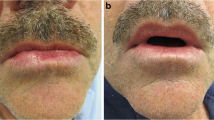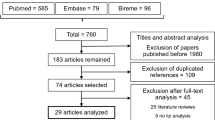Abstract
Objectives
The objective of the study is to assess, by clinical follow-up, the efficacy of the dermatological cream Fludroxycortide 0.125 mg/g (Drenison®) in the treatment of actinic cheilitis (AC).
Material and methods
Twenty-three patients diagnosed with AC participated in the study. Fifteen were submitted to corticotherapy with Fludroxycortide, applied three times a day for up to 6 weeks, associated with lip sunscreen (LS) before sun exposure. In the control group of eight patients, only the use of LS was established. At each weekly return, a photographic record was made of the lesion. After treatment, images were evaluated and scores were assigned to verify clinical evolution. Also, patients treated with Fludroxycortide responded to a questionnaire, to assess drug tolerability and treatment satisfaction.
Results
In the group treated with Fludroxycortide (n = 15), five patients showed total improvement, seven presented partial improvement, and three showed no clinical change. Concerning the patients treated with LS (n = 8), one presented total remission of the clinical lesion characteristics, four exhibited partial improvement, and three exhibited no clinical lip alteration. No case presented symptom worsening. Of the 15 patients undergoing corticotherapy, 12 were satisfied and reported that the product was not irritating and contributed to lesion improvement.
Conclusions
Conventional treatment with LS was effective in the remission of some AC lesions, but treatment responses were improved when associated with Fludroxycortide, especially in the more severe cases.
Clinical relevance
As it is a non-invasive therapy leading, in most cases, to adequate clinical results, safety, and tolerability, Fludroxycortide can be considered an effective alternative treatment for AC.


Similar content being viewed by others
References
Freddo AL, Vogt BF, Torriani MA, Hosni ES (2009) Vermilionectomy: a treatment alternative for actinic cheilitis. Rev odonto ciênc 24(3):319–322
Bertini FR, Sgarbi FC, Tera TM, Brandão AAH, Cavalcante ASR (2010) Histological analysis of the actinic cheilitis: an interobserver approach. Int J Dent 9(1):6–10
Jadotte YT, Schwartz RA (2012) Solar cheilosis: an ominous precursor: part I. Diagnostic insights. J Am Acad Dermatol 66(2):173–184
De Souza Lucena EE, Costa DCB, Da Silveira EJD, Lima KC (2012) Prevalence and factors associated to actinic cheilitis in beach workers. Oral Dis 18(6):575–579
Arnaud RR, Soares MSM, Paiva MAF, Figueiredo CRLV, Santos MGC, Lira CC (2014) Queilite actínica: avaliação histopatológica de 44 casos. Rev Odontol UNESP 43(6):384–389
Santana Sarmento DJ, Costa Miguel MC, Queiroz LM, Godoy GP, Silveira EJ (2014) Actinic cheilitis: clinicopathologic profile and association with degree of dysplasia. Int J Dermatol 53:466–472
Dancyger A, Heard V, Huang B, Suley C, Tang D, Ariyawardana A (2018) Malignant transformation of actinic cheilitis: a systematic review of observational studies. J Investig Clin Dent 9(4):e12343
Cavalcante ASR, Anbinder AL, Carvalho YR (2008) Actinic cheilitis: clinical and histological features. J Oral Maxillofac Surg 66:498–503
Schwartz RA, Bridges TM, Butani AK, Ehrlich A (2008) Actinic keratosis: an occupational and environmental disorder. J Eur Acad Dermatol Venereol 22(5):606–615
Wood NH, Khammissa R, Meyerov R, Lemmer J, Feller L (2011) Actinic cheilitis: a case report and a review of the literature. Eur J Dent 5(1):101–106
Lopes ML, Silva Júnior FL, Lima KC, Oliveira PT, Silveira ÉJ (2015) Clinicopathological profile and management of 161 cases of actinic cheilitis. An Bras Dermatol 90(4):505–512
Nico MMS, Rivitti EA, Lourenço SV (2007) Actinic cheilitis: histologic study of the entire vermilion and comparison with previous biopsy. J Cutan Pathol 34(4):309–314
Vieira RA, Minicucci EM, Marques ME, Marques SA (2011) Actinic cheilitis and squamous cell carcinoma of the lip: clinical, histopathological and imumunogenetic aspects. An Bras Dermatol 87(1):105–114
Savage NW, McKay C, Faulkner C (2010) Actinic cheilitis in dental practice. Aust Dent J 55(1):78–84
Huber MA (2010) White oral lesions, actinic cheilitis, and leukoplakia: confusions in terminology and definition: facts and controversies. Clin Dermatol 28:262–268
Ulrich C, Forschner T, Ulrich M, Stockfleth E, Sterry W, Termeer C (2007) Management of actinic cheilitis using diclofenac 3% gel: a report of six cases. Br J Dermatol 156(3):43–46
Lima Gda S, Silva GF, Gomes AP, de Araújo LM, Salum FG (2010) Diclofenac in hyaluronic acid gel: an alternative treatment for actinic cheilitis. J Appl Oral Sci 18(5):533–537
CORDRAN® SP CREAM (2013) San Antonio: Manufactured by DPT Laboratories, 2013. Bula de remédio. http://www.accessdata.fda.gov/drugsatfda_docs/label/2013/012806s037lbl.pdf. Acessed 28 April 2018
DRENISON® (2014) Farmacêutico responsável: Dr. Dante Alario Junior São Paulo: Avert Laboratórios Ltda, 2014 Bula de remédio http://wwwanvisagovbr/datavisa/fila_bula/frmVisualizarBulaasp?pNuTransacao=9007102014&pIdAnexo=2253250. Acessed 28 April 2018
Kujan O, Oliver RJ, Khattab A, Roberts SA, Thakker N, Sloan P (2006) Evaluation of a new binary system of grading oral epithelial dysplasia for prediction of malignant transformation. Oral Oncol 42(10):987–993
Nelson CG, Spencer J, Nelson CG Jr (2007) A single-arm, open-label efficacy and tolerability study of diclofenac sodium 3% gel for the treatment of actinic keratosis of the upper and lower lip. J Drugs Dermatol 6(7):712–717
Martins-Filho PR, Da Silva LC, Piva MR (2011) The prevalence of actinic cheilitis in farmers in a semi-arid northeastern region of Brazil. Int J Dermatol 50:1109–1114
Piñera-Marques K, Lorenço SV, Silva LF, Sotto MN, Carneiro PC (2010) Actinic lesions in fishermen’s lower lip: clinical, cytopathological and histopathologic analysis. Clinics (Sao Paulo) 65(4):363–367
Shah AY, Doherty SD, Rosen T (2010) Actinic cheilitis: a treatment review. Int J Dermatol 49(11):1225–1234
Chaves YN, Torezan LA, Lourenço SV, Neto CF (2017) Evaluation of the efficacy of photodynamic therapy for the treatment of actinic cheilitis. Photodermatol Photoimmunol Photomed 33(1):14–21
Cox DP, Ferreira L (2017) The Oral effects of inhalation corticosteroid therapy: an update. J Calif Dent Assoc 45(5):227–233
Gonzaga AKG, de Oliveira PT, da Silveira ÉJD, Queiroz LMG, de Medeiros AMC (2018) Diclofenac sodium gel therapy as an alternative to actinic cheilitis. Clin Oral Investig 22(3):1319–1325
Funding
This study was funded by the authors and supported by the Department of Dentistry, Federal University of Rio Grande do Norte.
Author information
Authors and Affiliations
Corresponding author
Ethics declarations
Conflict of interest
The authors declare that they have no conflict of interest.
Ethical approval
All procedures performed in studies involving human participants were in accordance with the ethical standards of the institutional and/or national research committee and with the 1964 Helsinki Declaration and its later amendments or comparable ethical standards. The study was approved by the Ethics Committee of the Federal University of Rio Grande do Norte (Protocol 1.846.133).
Informed consent
Informed consent was obtained from all individual participants included in the study.
Additional information
Publisher’s note
Springer Nature remains neutral with regard to jurisdictional claims in published maps and institutional affiliations.
Rights and permissions
About this article
Cite this article
de Oliveira Bezerra, H.I., Gonzaga, A.K.G., da Silveira, É.J.D. et al. Fludroxycortide cream as an alternative therapy for actinic cheilitis. Clin Oral Invest 23, 3925–3931 (2019). https://doi.org/10.1007/s00784-019-02823-1
Received:
Accepted:
Published:
Issue Date:
DOI: https://doi.org/10.1007/s00784-019-02823-1




